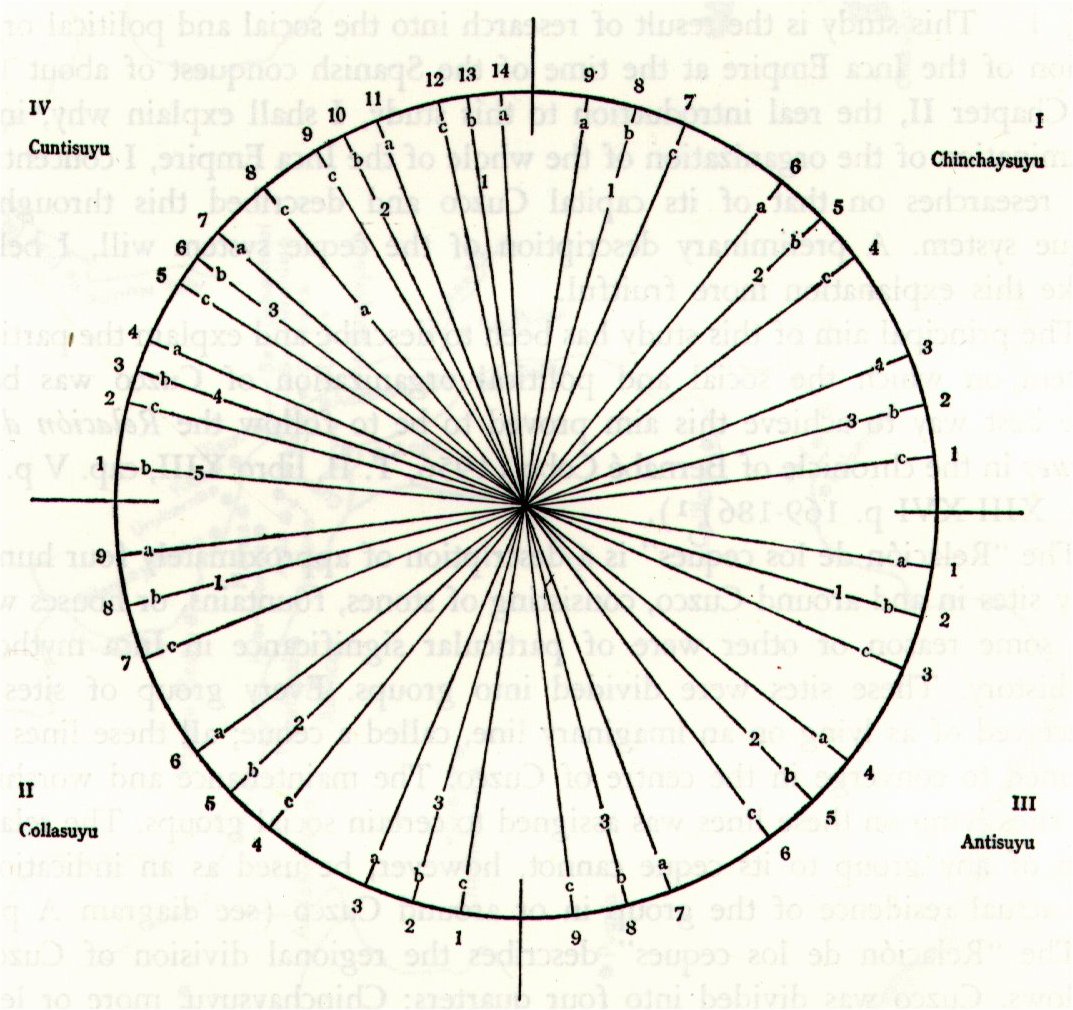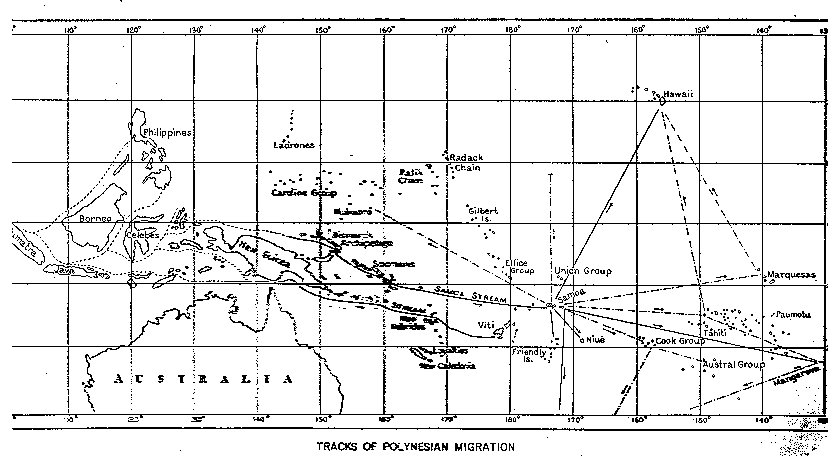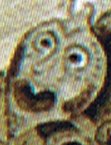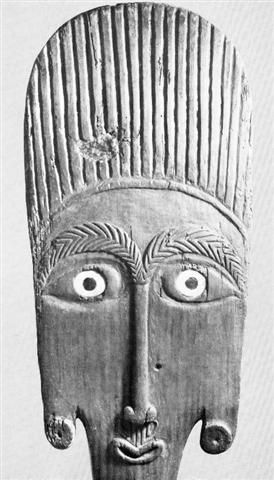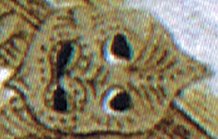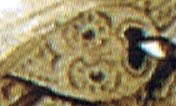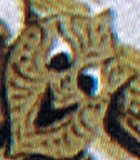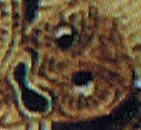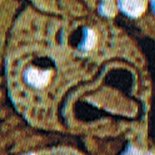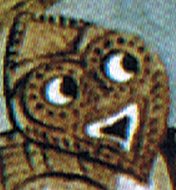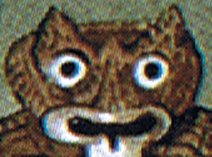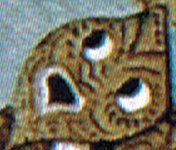|
TRANSLATIONS
From Tahua we received the idea of the night being divided into 8 parts, with midnight in the 'middle'.
There are 12 glyphs, 7 in the upper line and 5 in the bottom line. 5 glyphs are marked red (a sign for 'light') and 7 are marked blue (a sign for 'darkness'); where possibly number 5 is an allusion to the 5 intercalendary nights in between two years and 7 and allusion to the number of nights in a week. But the red and blue marks are mine, a tentative conclusion based on my interpretation of the meanings of the glyphs and the idea that there should be 4 or 8 subdivisions of the night (4 red / 'male' and 4 blue / 'female'). There is light in the night as well as darkness during the day. The 12 solar ('male') months in the 'canoe' of the year have company from their 12 'females' (and there are 24 hours in a day). Henua (Aa1-43) presumably indicates the threshold to the new day, but a threshold is located in between the two 'rooms' and we should therefore perhaps change the structure somewhat. In China they had a double-hour from 11 p.m. covering the midnight 'vacuum' between the two days. On the other hand there emerges another structure contradicting such a change:
I believe that there is a kind of similarity between henua and vaka. Maybe they are both expressions of mother earth, henua the dry (old) land and vaka a symbol for the waters which will be traversed to the new land.. When a double-canoe is loaded with people, poultry and plants it is like a little planet of plenty on its own: "Hotu's time came, and Matua spoke to Hotu: 'Put the canoe (miro) into the water and sail to Te Pito O Te Kainga. For five months Ira has been searching for the land. Ira went away and did not return.'
Then Matua said to Hotu, 'Launch the canoe, gather the people, and sail on board the canoe to Te Pito O Te Kainga. Sail on and let children be born by the many in Te Pito O Te Kainga [i.e., the number of your subjects will increase in the new homeland]. Not one thing shall remain behind [i.e., everything that is needed will be taken along] when you leave!' Hotu said to his assistants Teke and Oti, 'Go and take banana shoots, taro seedlings, sections of sugarcane to be planted, yam roots, sweet potatoes with leaves (? rau kumara), hauhau trees, paper mulberry trees, sandalwood trees, ferns (riku), rushes, yellow roots, tavari plants, moss (para), and ngaoho plants. Take all of these things [i.e., all varieties of plants] and also grass!' Then King Hotu said to Teke, 'Don't forget the four-legged animals (manu vae eha 'birds with four legs'), also pigs (? kekepu), chickens, and birds.' Then King Matua said to Hotu, 'You must not forget the flies when you take along (all the things that are necessary) and sail off. If you forget the flies, the multitude (piere) of the people will disappear. When you reach the land to which you are travelling, it will be over quickly (?) for the multitude of the people. When the flies die, the human population dies too.' Then King Hotu said to Teke and Oti, 'You two will forget what I have said [i.e., you will keep it a secret]?' Teke answered. 'Yes!' ..." (Barthel 2)
Names give information. Not only is the name Ira suitable for somebody who is sent out to look ('behold') and do reconaissance ('turn around to look'), but also the pair Teke and Oti conveys meaningful information, because we can hear that they are 'brothers': both names tell about 'endings'. We recognize oti at the root of kotikoti:
Furthermore, there are more than one 'ending' (way to die); in Churchill 2 we read: "The employment of oti in Samoa for the death of a man is not so much euphemism as the paying of proper respect to the superior animal, for oti ... means finished. To the high-minded Samoan there can be no sympathy with Ecclesiastes: 'the sons of men are a chance and the beasts are a chance, and one thing befalleth them; as the one dieth, so dieth the other; yea, they have all one spirit; and man hath no preeminence above the beasts.' Not the meanest Samoan sinks to the level of the brute, even in the article of death. The beast dies, the humblest of men at least finishes. For them of high degree there is yet more compliment; the head of the house dies not, but goes to the council (usufono), the chief goes on in majesty (maliu, afio), the heavens are rent in twain (masaesaelelangi), and the rain beats down (timuto). Certain families die with circumstance. Death comes not to Tangaloa, he has but gone far afishing (ta'atiu); and similarly on Asiata's demise the stools of bamboo are swept clean away (tafealetau'ofe), such a fishing has he gone upon. When Tuala goes the very winds hold their peace (matangitongaina); over the funeral mats of Fiamē the moon comes tumbling out of the sky (pā'ūlemasina); when Mata'afa leaves the earth the heavens are turned upside down (mafulilelangi). If this be euphemism it is of the nth power." The more blunt 'death' is mate:
If we now once again reorder the glyphs in Tahua, I would suggest this:
The message is clear: 4 * 7 = 28 ('moon') and 2 * 6 = 12 ('sun'). We may also count vertically: 4 + 2 = 6 (number of solar double-months in a year) and 7 + 6 = 13 (number of lunar month in a year; 13 * 28 = 364). The concept of double-month maybe is expressed in the fact that there are double 4 marks in the maro, if so then presumably solar double-months. For lunar double-months we find 8 marks in the 5th glyph (if we think 8 * 7), but there are also 8 periods in the lunar calendar (at least in Mamari). I believe this structure is what the writer had in mind. Now we are prepared for looking at the parallel structure in P:
The structure is similar but different. In sympathy with the idea that the calendar of the 'day' should start with the night (in H, P and Q) there is 'death' printed all the way through the night part of the calendar. Sun will not appear until dawn (and then in the day part of the calendar). But at the start of the night there is a similarity with the text in A, where 4 (marked red by me) appears as the 'end of day' part, maro. There is also a similarity with A in dividing the night inyo two at midnight - because we can see that until midnight there are two 'arms', after midnight only one:
Number one indicates the male and number two the female. Zero ('red' period above) is a way to indicate end and beginning: neither male nor female. In mathematics we assign neither + nor - to zero, we use both: ±. I think we should read that sign instead as 'death', I can see a cross standing upon the surface of the earth. The 'green' period starts at midnight with the birth of a new 'day'. Even the creator of the P text acknowledges that. Both the texts (A and P) contain 19 glyphs (4 + 9 + 6 respectively 4 + 8 + 7) and possibly this indicates the number of years in the Metonic cycle. "The Greek astronomer Meton of Athens introduced a formula for intercalation in 432 BC. It was his observation that a period of 19 solar years is almost exactly 235 lunar months, and rounded to full days counts 6940 days. The error is only 2 hours between 19 years and 235 months. Also this defines the length of the year to be 365 + 1/4 + 1/76 days: this is only 31 minutes longer than the tropical year. 7 of the 19 years would have an intercalated month." (Internet - Wikipedia) The 'green' quarter of the 'day', i.e. the beginning of the 'day', is most important. In Old Babylonia that was where Marduk slayed the night 'monster' Tiamat, where he cut her in two. He must have been at his strongest at that time. From a mythical point of view the 1st quarter of the 'day' is therefore more 'light' than the rest. Among the Incas we can see this in their system of ceque:
I (Chinchay-suyu) was the 'white' quarter where the Inca rulers lived, II (Anti-suyu) was a mixed quarter, III (Colla-suyu) was also a mixed quarter, and then IV (Cunti-suyu) was 'black'). But to explain we must start from the beginning, where we have a division in two: Hanan (right, male, high etc) and Hurin (left, female, low etc): "...yet another principle of Andean order in space and time: the division into hanan (upper) an hurin (lower) halves, or moieties. It probaby has its origins in the geographical facts of life in Peru - hanan groups are the first to receive the irrigation water that runs through their land. Powerful social constraints must be imposed to ensure that hurin people, living lower down, get their share of the life-giving fluid. Their groups therefore intermarry. But the duality extends far beyond the practical to form a structure of symbolic order as fundamental as the Chinese yin and yang: the Andes are hanan in relation to the coast and jungle; the present is hanan in relation to the past; male is hanan, female hurin; and so on. Lower does not necessarily mean inferior; the Creator, Wiraqocha, is hurin because of his association with water; while Inti, the Sun, created by Wiraqocha, is hanan because of his association with light and heat." (The Two Worlds of Peru) The 'day' (if we translate this Peruvian world view into the calendars we study) is divided into a first 'male' part (from midnight to noon) and a second 'female' part (from noon to midnight). Next division in two cuts across both these halves: "The chronicles indicate that the primary kin of the ruler were considered as belonging to Chinchaysuyu [I] and the subsidiary kin to Collasuyu (II) and at the same time that Chincaysuyu and Collasuyu were also indicated by Hanan-Cuzco and Hurin-Cuzco." (Zuidema) Here - suddenly - the perspective changes, where we had Hanan as 'male' and Hurin as 'female' we get Hanan-Cuzco as 'high' and Hurin-Cuzco as 'low'. But still Cuzco is hanan. Although Hanan-Cuzco of course must be more hanan than Hurin-Cuzco. I.e. there must be a mixture with 'black' / 'hurin' in Hurin-Cuzco. The complexities rise quickly with a second double division in two. "... in the passages cited ... from Cobo, Molina and Sarmiento, Chincaysuyu [I] and Antisuyu [II] together were called Hanan-Cuzco (because the panaca of the rulers of Hanan-Cuzco belonged to these two suyu) and Collasuyu [III] and Cuntisuyu [IV] together were called Hurin-Cuzco (because the rulers of Hurin-Cuzco belonged to these two suyu). Other chroniclers, however, call only Chincaysuyu [I] Hanan-Cuzco, and Collasuyu [III] Hurin-Cuzco." (Zuidema) "According to Betanzos, the ruler - and probably all his predecessors and successors - with his primary kin belonged to I and his subsidiary kin to II... Non-related people belonged to III + IV." (Zuidema) "Every ruler was supposed to have founded his own panaca. These panaca were social groups which were said to consist of the descendants of the ruler, with the exception of the son who succeeded him. [Reasonable, because he must have his own panaca.] ... The panaca of the first five rulers were said to belong to one half of the population of Cuzco, which was called Hurin-Cuzco, or Lower Cuzco, and the panaca of the next five to Hanan-Cuzco, or Upper Cuzco..." (Zuidema) This theoretical system broke down of course with the 11th ruler (Huayna Capac). The last ruler was number 13, Atahuallpa, who was brutally murdered by the Spaniards. An unlucky ruler, he was, cut off as if he was lunar month no. 13. But it surely must have been his fate. I believe that there must be a causal relationship between the ceque system and the idea among the Hawaiians about being connected to their ancestors by 'umbilical cords'. The lines in ceque from the center out towards different points around the circular perimeter certainly were measured out with the aid of strings. Like the birthdays in our system it was connected with the calendar of the year. Some influence from ceque would therefore be expected to fall also on the calendar of the 'day'. In the old days there probably was communication all around and across the great ocean. In Churchill 2 there is convincing evidence to prove that the Polynesians moved from somewhere in southeast Asia, travelling in two waves in a southeasterly direction (first 'Proto-Samoan' and later 'Tongafiti' according to the terminologi in Churchill 2).
They reached Easter Island but then their traces are lost. Certainly, I believe, they went on until they reached South America. But why should they stop there? Polynesians are island peoples and therefore they did not stay for long on the continent. Some probably returned via the Marquesas, some by a more northerly route to Hawaii: "In the last century G. M. Dawson lived among the Kwakiutl people of northern Vancouver Island and adjacent coasts and recorded their main tribal memories, which centered upon a migrant culture hero from whose younger brother the chiefly families reckoned their divine descent: 'The name of this hero, like other words in the language, is somewhat changed in the various dialects. After hearing it pronounced by a number of individuals in the northern part of Vancouver Island and on the west coast, I adopted Kan-e-a-ke-luh as the most correct rendering. The nawitti people use a form more nearly rendered by Kan-e-a-kwe-a.' He also quotes a myth, however, where the same deity is referred to with yet another suffix, as Kani-ke-laq. The Kan-e legends end with the belief that he in the end married 'a woman from the sea' and went away over the ocean, disappearing forever from mortal ken so that 'the people suppose the sun to represent him...' The close connection of the culture-hero, Kan-e-a-ke-luh, with the sun, has appeared in the tales concerning him, together with the belief that the chiefs, or some of them, are related to Kan-e-a-ke-luh by descent through his younger brother. Doubtless, also, in connection with this, we find that the sun, na-la, under the name Ki-a-kun-a-e, or 'our chief', was formerly worshiped and prayed to for good health and other blessings.' Boas too, in his monograph on Kwakiutl Tales, shows that the hero he refers to as Qaneqelak or Kane-ke-lak was the principal god and divine ancestor of the local people, who finally departed, saying he wanted to go to more southerly latitudes. We need go no further south than Hawaii, where like Fornander we find that tribal memories ascribe the discovery of their group to a mythical 'wandering chief' who came from a vast island or mainland farther north which was never mentioned by its real name, but only alluded to as 'the lost home of Kane'. The sun, in Kwakiutl language na-la and Hawaiian language similarly la (ra in other Polynesian dialects) was also in Hawaii alluded to as 'the resting place of Kane'. Kane was venerated in Hawaii as the principal god and direct ancestor of ruling families, whereas the Kwakiutl people claimed descent from the younger brother of Kan-e. Collecting Hawaiian beliefs in the last century, A. Fornander stated: 'This Kane creed, such as it has been preserved in Hawaiian traditions, obscured by time and defaced by interpolations, is still a most valuable relic of the mental status, religious notions, and historical recollections of the earlier Polynesians. No other group in Polynesia has preserved it so fully, so far as my inquiries have been able to ascertain; yet I have met with parts of it on nearly all the groups, though more or less distorted, and in that case I hold that the universality of a legend among so widely scattered tribes proves its antiquity.' One of Kane's full names in Hawaii was Kane Uakea, 'Kane the Light', which corresponds closely to the Kwakiutl Kan-e-a-kwe-a recorded by Dawson." (Heyerdahl 2) I think that we should label the quarters of the day with the roman numbers (I, II, III and IV) to remind us about the Inca system. Thereby we will also remember the colour values:
No wonder that the sun we see today is just a shadow of himslef. By chance (?) I happen to notice a relevant picture of a Taranaki (New Zealand) storehouse in Starzecka:
The middle figure with a head like a cat is male and white, the two females linked with him have non-white arms. The 1st and 5th figures are strange mixtures: though evidently male their bodies are covered with what looks like dark strings and their heads seems to be female in character. Possibly this horizontal group of 5 is related to the 5 extracalendrical days when 'gods are born'. The roof is divided into two, where the left half (from us seen) contains a white sinous form composed of 3 'snails' with curious heads. Though the 'snails' probably are 'limbs' - cfr the legs of the five 'persons' in the horizontal row. The right half of the roo starts (at top) with an egg, then comes an empty space, and then it ends with 2 interlinked creatures. The roof possibly illustrates the periods II (left) and III (right), implying that the horizontal bottom part must be IV and I (in a clockwise reading), i.e. the bottom part would be 'winter' (from autumn equinox to spring equinox). The roof of the house in the background also has, and at the top there stands what looks like a rongorongo glyph, cfr Ab7-36:
Maybe we here have two beads on the string of time, a suitable symbol for the pillar marking midsummer (where the rule of II is ending and the rule of III begins). At the top of the storehouse an egg probably is used with a similar intention. Perhaps we should understand that egg as containing the embryo of the next day, which will be hatched 9 months later at 'dawn', the beginning of next II. On the storehouse roof we find III containing not only the egg, but also an empty space - i.e. a non-white part. At the end of III white is returning, now stronger than ever. Presumably we should read this as the time of harvest, when everything is ripe. I remember the fat and low sun-disc in Aa1-32:
However, given that there once was a common world-picture all over a vast area (from Egypt to India to Southeast Asia to Easter Island to South America) then the evidence on Easter Island points to another interpretation of the roof of the storehouse: The sacred geography of Easter Island is triangular in shape, not circular. We have seen that Poike marks 'noon' and that the base of the triangle lies in the west (from whence their ancestors came, the land of the dead). The storehouse would - if congruent - have the west (the past) as its base and the two roof sections would be rising sun and declining sun. The horizontal base must be made broad in order to establish the straight rising and straight declining paths of the sun, but in time-space the horizontal base indeed is no more than those 5 extracalendrical nights at winter solstice. We should not think in terms of I, II, III and IV. The primordial system seems to have divided the cosmos into three parts: a) the extracalendrical 5 nights, b) the 'male' calender period from winter solstice to summer solstice, and c) the 'female' declining period from summer solstice to the end of the year. The 'male' (rising) part of this calendar is marked by '1' and the 'female' (declining) part is marked by '2'. With this picture in mind we also reach a better understanding of the two 'staffs' of the central sun god at Tiahuanaco:
With a clockwise reading we can see the '1' staff at left and the '2' staff at right (i.e. in his right respectively left hands). The dark part (winter) is below and the light part (summer) is above his middle. Stimulated by the wealth of detail in the storehouse picture (painted by Charles Heaphy, 1840) I enlarge the 10 heads:
We must stop here, or we will be drowned in an avalanche of ideas. Back to the trail: The first glyph of the night in P is a 'zero'-tôa (no 'arms'), which could mean that we have a kind of introduction to the night, Pa5-19:
This glyph (GD47, tôa) has 4 marks shaped like sharkfins. I suggest sharkfins because sunflames would not give the associations required for an introduction to the night. The shark, however, is a creature of the deep: 'The shape of a shark against the bottom of coral sand is like a dark shadow and the shark is associated with darkness.' "Fetu-tea [Pale Star = Saturn] was the king. He took to wife the dome of the sky, Te-Tapoi-o-te-ra'i, and begat stars that shine (hitihiti) and obscure, the host of twinkling stars, fetu-amoamo, and the phosphorescent stars, te fetu-pura-noa. There followed the star-fishes, Maa-atai, and two trigger-fishes that eat mist and dwell in vacant spots in the Milky Way, the Vai-ora or Living-water of Tane. The handsome shark Fa'a-rava-i-te-ra'i, Sky-shade, is there in his pool and close by is Pirae-tea, White Sea-swallow (Deneb in Cygnus) in the Living-waters of Tane." (Makemson) The 4 'sharkfins' make us think about the square earth and at the same time about the four phases of the moon. Night is the domain of the moon. To interpret the 4 'fins' as the tips of two moon sickles cannot be right, because that does not fit with the outline of the glyph. A shark is called magó but alternatively - and more adequately I believe - mogó in the idiom of Easter Island. Because mogó sounds like moko (GD87), lizard, and give associations of disappearance and death:
Furthermore, on Marquesas they are said to have used the word moko for magó:
Maybe Churchill made a mistake here, intending to write mogo but wrote moko. But such a curious mistake certainly is relevant (meaningful) for someone as careful and orderly as Churchill. The main part of Pa5-19 is tôa = sugar cane. The problem of combining sugar cane with warrior (to'a) is not impossible to solve. Consider first that sugar cane is a cane, which must mean that it is hollow and therefore similar to bamboo and reeds. I think this similarity explains why it is necessary to start the night with tôa (and not with to'a). Secondly we should remind ourselves about how the little Hawaiian boy survived the threat of death: 'The little spring was concealed by a succulent growth of strange plants, bearing gigantic leaves and pendant clusters of long yellow fruit, which she named bananas. The intervening space was filled with a luxuriant growth of slender stems and twining vines, of which she called the former sugar-cane and the latter yams ...' Bananas, sugarcane and yams. Yam is uhi (as in uhi tapamea) and sugarcane is tôa (as in tôa tauuru). What are bananas called in Rapanui? What does bananas symbolize? I would guess that a banana could be a symbol for the yellow moon (night). Then we would have first moon (night), then the periods of the night (tôa) and at last the periods of the day (uhi), all in correct mythological order. We can check in Barthel's table over important Easter Island plants to see where the bananas are located:
They are placed in the food column and are called maîka. (I have coloured red here just to easily find those three plants we are investigating - no intention from my side of indicating 'light' this time.)
Row C should (according to my interpretation) mean Tuesday, i.e. be associated with Mars (not with the Moon). I remember the curious name for Tuesday in Churchill: po e rua, which hardly means 'the second night' (of the week). Although the sun is not visible in the night. Therefore it would perhaps be possible to read po e rua as the second night - because Sunday is a day, not a night. Instead the meaning of po e rua could be the night with two 'faces' (the planet Mars having two appearances, bright and near or dim and far away). In other words: Tuesday and Mars give associations to 2. 4 'sharkfins' in Pa5-19 points at earth and moon, 2 in the Y of tôa points at the second half of the 'day'. The sign of Y works like Tuesday. But the 4 'sharkfins' / earth / moon could mean IV, i.e. the quarter where the mysterious regenerations happen, the habitat of the moko (or mo'o in Hawaiian): '... When the man, Ulu, returned to his wife from his visit to the temple at Puueo, he said, 'I have heard the voice of the noble Mo'o, and he has told me that tonight, as soon as darkness draws over the sea and the fires of the volcano goddess, Pele, light the clouds over the crater of Mount Kilauea, the black cloth will cover my head ...'
|
|||||||||||||||||||||||||||||||||||||||||||||||||||||||||||||||||||||||||||||||||||||||||||||||||||||||||||||||||||||||||||||||||||||||||||||||||||||||||||||||||||||||||||||||||||||||||||||||||||||||||||||||||||||||||||||||||||||||||||||||||||||||||||||||||||||||||||||||||||||||||||||||||






